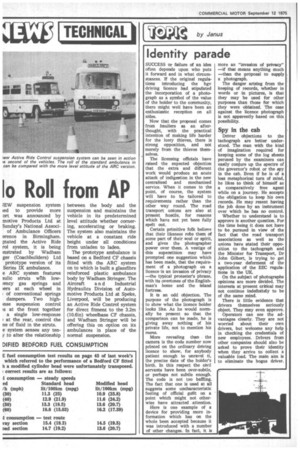Identity parade
Page 32

If you've noticed an error in this article please click here to report it so we can fix it.
SUCCESS or failure of an idea Often depends upon who puts it forward and in what circumstances. 7f the original regulations introducing the [Igo driving licence had stipulated the incorporation of a photograph as a symbol of the value of the holder to the community, there might well have been an enthusiastic reception on all sides.
Now that the proposal comes from hauliers as an afterthought, with the practical intention of making life harder for the lorry thieves, there is strong opposition, and not merely from the thieves themselves.
The licensing officials have raised the expected objection that the extra and different work would produce an acute attack of indigestion in the new centralised and mechanised service. When it comes to the point, of course, the system will have to lbe tailored to requirements rather than the other way round. The road transport unions are also at present hostile, for reasons which have not yet been fully spelt out.
Certain primitive folk believe that their likeness robs them of , some part of their soul or spirit, and gives the photographer power over them. A vestige of this superstition may have prompted one suggestion which has been made, that the requirement of a photograph on a licence Is an invasion Of privacy —the typical protester's phrase, with its overtones of the Englishman's home and the island fortress.
k is an odd objection. The purpose of the photograph is to show what the licence holder looks like. As he would normally be present so that the comparison can be made, he is giving away nothing of his private life, not to mention his mane.
More revealing than • the camera is the .code number now printed on the ordinary driving licence to show, for anybody patient enough to unravel it, the precise date of the holder's birth. In this respect the civil servants have been over-subtle, or perhaps not subtle enough. The code is not too baffling. The fact that one is used at all suggests some uncharacteristic feeling of official guilt an a point which might not Otherwise have attracted attention.
Here is one example of a device for providing more information which has on the whole been accepted because it was introduced with a number of other changes. in fact, it is more an "invasion of privacy" —if that means anything much —than the proposal to supply a photograph.
The danger arising from the keeping of records, whether in words or in pictures, is that they may be used for other purposes than those for which they were obtained. The case against the licence photograph is not apparently based on this
Spy in the cab
Driver objections to the tachograph are better understood. The man with the kind of imagination required for keeping some of the log sheets perused by the examiners can easily conjure up the spectre of the governor's robot or the spy in the cab. Even if he is of a less metaphorical turn of mind, he likes to think of himself as a comparatively free agent while on a journey. He accepts the obligation to keep his own records. He may resent having the job done by an instrument over which he has no control.
Whether to understand is to approve is another question. For the time being it does not have to be pursued in view of the fact that the road transport. associations as well as the unions have stated their opposition to the tachograph and the Minister for Transport, Dr John Gilbert, is trying to get a two-year deferment of the application of the EEC regulations in the UK.
On the subject of photographs opinions are more divided. The interests at present critical may not continue indefinitely to be of the same mind.
There is little evidence that drivers themselves seriously object. They may even approve.
Operators can see the advantages clearly. They are not worried about their own drivers, but welcome any help in checking the credentials of new employees. • Drivers from other companies should also be asked to prove their identity when they arrive to collect a valuable load. The main aim is to eliminate the bogus driver.
















































































































